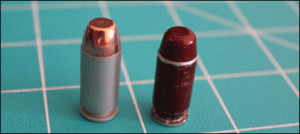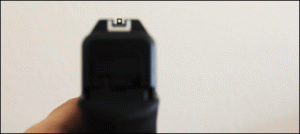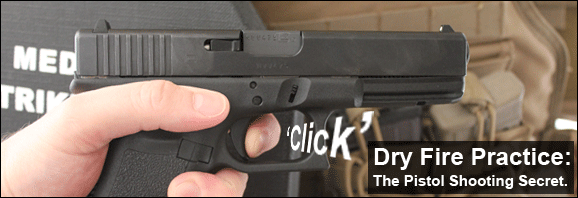Instructional video was added to this article in 2016.
If you read my last article ‘Maximizing Your Range Time’, then you will remember that I repeatedly promised to write a follow-up about Dry Fire Practice. Well here it is, so let’s get started. As any instructor should, I will start this article off with a little safety brief. It is imperative that you follow proper safety while handling your firearm. During these Dry Fire drills you will be pulling the pistol’s trigger, so it is even more important (as if it could be more important) to ensure your firearm is unloaded and that there are no loaded magazines or spare rounds within reach. Anytime you lay the weapon down, be in the habit of checking the chamber again as soon as you pick it up just to ensure the weapon is empty.
Now, just a little bit about the equipment. Different pistols can be Dry Fired with nothing in the chamber. Others cannot without suffering damage. You need to consult your firearm’s manual or directly with the manufacturer about this. No rimfire pistol should ever be Dry Fired on an empty chamber. If you are not sure then I highly recommend heading to your local outfitter and purchasing a few snapcaps in your weapon’s caliber. Snapcaps are simply fake bullets. They do nothing when fired but sit in the chamber. I am a Glock shooter myself and personally have run tens of thousands of Dry Fired rounds through my weapons on an empty chamber. I have experienced no problems what-so-ever but I do encourage you to research this for yourself.

What is Dry Fire?
What are we trying to fix?
You, as a human, are designed to react to danger. When firing live ammunition your brain interprets the ‘BANG!’ and recoil as something that needs your attention. While shooting through a magazine your brain starts to anticipate the ‘BANG!’ and recoil. As a result, the muscles that control your hand jitter or jump a small amount. This transfers directly into your weapon usually forcing the barrel down a bit. The smallest movement at your weapon means drastic changes at your bullet’s point of impact on the target.
Don’t believe it? Let me prove it.
The next time you go to the range bring a friend and a few snapcaps with you. Turn your back and tell your friend to load your magazine with several rounds and to hide a snapcap somewhere in the stack (hint: Have your friend load at least 7 rounds in the magazine placing the snapcap somewhere in the middle.) Your assistant should place the magazine 90% into the weapon allowing you to seat it the rest of the way. This prevents you from seeing where the snapcap is located through the magazine’s inspection ports. Now, make ready and get on target. Begin firing at your own pace and try not to think about the snapcap. ‘BANG!’ ‘BANG!’ ‘BANG!’ ‘click’. What happened? I bet your gun barrel dipped downward just a slight bit, didn’t it? (IMPORTANT: remember that your weapon still has live rounds in it at this point.)
Your brain was anticipating another recoil and a ‘BANG!’, but instead you got a ‘click’ when the snapcap was ‘fired’. Your brain told your muscles to counter the recoil (which goes upward) with a slight downward flinch. That seems like a good thing considering two equal forces in the opposite direction should cancel each other out. Sadly, your reflexes are not that good. So your surge of anticipation, forcing the barrel down a little bit, actually happens before the round is fired (because your body ANTICIPATES the shot). That anticipation is most likely the single largest cause of your impacts drifting off of your desired point of impact.
How does Dry Fire Practice help?
By Dry Fire Practicing, you are training your brain to not anticipate the ‘BANG!’ You will notice that after you Dry Fire just a few rounds the front sight will begin to settle down and stay right where it is supposed to be (in between the two rear sight posts) as you press the trigger. Once you are satisfied with how your front sight post is behaving during your Dry Fire shots you are ready to fire some real ammo. If I was a betting man, I would say that your grouping has already improved.
The Steps
1.) Ensure your weapon is empty.
2.) Draw your weapon (if your range allows you to draw from a holster).
3.) Get on target with proper sight alignment and sight picture.
4.) Apply slow steady pressure to the rear of the trigger.
5.) As the weapon ‘clicks’ make sure to follow through with your trigger press.
6.) Release pressure on the trigger and give yourself a mental break (tell yourself the repetition is over).
7.) Rack your slide and reset to position 2.
8.) …repeat
There is nothing quick about Dry Fire Practice. Take your time and chill out. Get on target, apply slow steady pressure to the trigger, ‘click’, follow through, release trigger, mental break, rack slide, reset, repeat.

How often should I Dry Fire?
You cannot Dry Fire too much. With every successful Dry Fire repetition you are becoming a more stable shot and are more capable of scoring that first round hit. In fact, with every live (real ammunition) shot you take, it makes you a little worse in the area of anticipation. This is one of those rare situations where simulated practice is better than actual practice. Now you will of course need to spend a lot of time shooting live ammunition to learn how your weapon and the projectile behaves. You also cannot simulate bullet speed or drop during your Dry Fire Practice. It is widely accepted among competitive shooters that 90-95% of your practice should be Dry. This should be good news considering Dry Fire Practice is free.
Where can I dry fire?
Anywhere that you can legally have your weapon in your hand. Use your head, do not Dry Fire Practice in view of the public. Always be sure of your simulated target’s foreground and background just as you would with live ammunition. I Dry Fire Practice every night with about 100 repetitions and at least a full magazines worth before I start shooting live ammunition at the range. I will even take Dry Fire breaks from live ammunition at the range if my shots start to drift.
How can I Dry Fire a Controlled Pair (Double Tap)?
You can’t. It doesn’t matter anyway. You are training to ensure that first round hit. If you can hit the first round every time you should have no trouble making the second round hit.
What does it all mean?
As you can see, Dry Fire Practice not only identifies your problem (anticipation), but also corrects it. But remember, Dry Fire Practice is never over. You will never fix your anticipation problem for good. The more live rounds you shoot the more Dry Fire Practice you need to correct your brain’s bad habit of anticipation.
Now, let me guess. You are thinking that if you are ever caught in a situation where you must pull the trigger in self defence, you won’t have time to Dry Fire before you must send lethal rounds to the threat. That is okay because you went through your Dry Fire Practice the night before, right? Whether you are a Law Enforcement Officer or Civilian, carrying for your own protection, Dry Fire should always have been the last drill you completed with your weapon. Do it enough, (90-95% of your practice) and your brain’s default setting will be to not anticipate the recoil. That is, as long as you keep up your Dry Fire Practice.
For some reason Dry Fire Practice is the best kept secret in the pistol shooting world. It should be the first thing you are taught after the safety brief. The next time someone offers to “show you a thing or two” ask them one question: “How much do you Dry Fire?” Depending on their response, maybe it is you who should be doing the teaching. I hope that you have found this article helpful and remember, anticipation is all in your head.
~Brent Keltner
Mission Spec
www.MissionSpec.com
Original published on 12/30/11 at Mission Spec.com.

